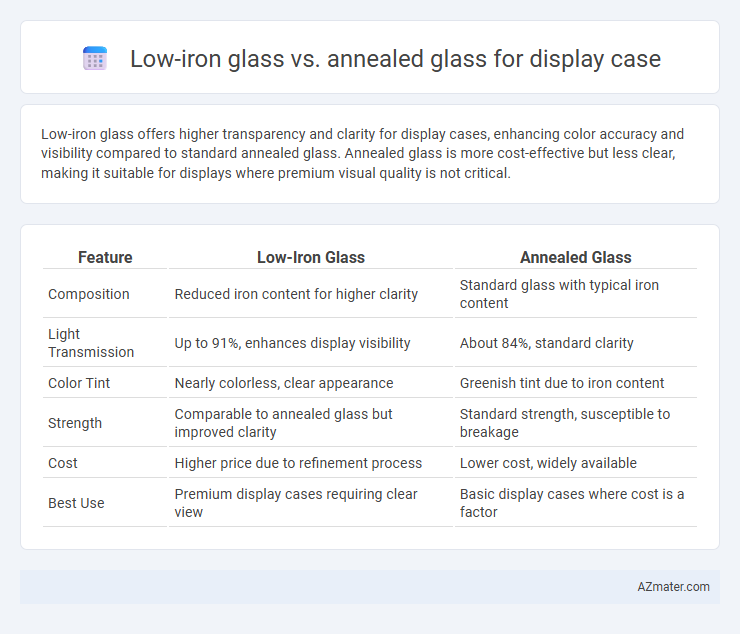Low-iron glass offers higher transparency and clarity for display cases, enhancing color accuracy and visibility compared to standard annealed glass. Annealed glass is more cost-effective but less clear, making it suitable for displays where premium visual quality is not critical.
Table of Comparison
| Feature | Low-Iron Glass | Annealed Glass |
|---|---|---|
| Composition | Reduced iron content for higher clarity | Standard glass with typical iron content |
| Light Transmission | Up to 91%, enhances display visibility | About 84%, standard clarity |
| Color Tint | Nearly colorless, clear appearance | Greenish tint due to iron content |
| Strength | Comparable to annealed glass but improved clarity | Standard strength, susceptible to breakage |
| Cost | Higher price due to refinement process | Lower cost, widely available |
| Best Use | Premium display cases requiring clear view | Basic display cases where cost is a factor |
Understanding Low-Iron Glass: Key Characteristics
Low-iron glass offers superior clarity and higher light transmission compared to annealed glass, making it ideal for display cases where color accuracy and unobstructed visibility are crucial. Its reduced iron content minimizes the greenish tint typical in standard annealed glass, enhancing the visual appeal of exhibited items. This type of glass also provides improved resistance to solar heat and UV rays, contributing to the preservation of sensitive displays.
What is Annealed Glass? Composition and Properties
Annealed glass is a type of soda-lime glass that has been slowly cooled to relieve internal stresses, resulting in a uniform and stable structure ideal for display cases. Its composition primarily includes silica, soda ash, and limestone, offering clarity, durability, and ease of fabrication but lower strength compared to tempered glass. While annealed glass provides moderate impact resistance and can be cut or drilled after production, it lacks the enhanced safety features of low-iron glass, which offers higher optical clarity and minimal green tint due to reduced iron content.
Light Transmission Comparison: Low-Iron vs Annealed Glass
Low-iron glass offers superior light transmission, typically around 91%, compared to annealed glass, which transmits approximately 89%. This increased clarity enhances visibility and color accuracy within display cases, making low-iron glass ideal for showcasing valuable or detailed items. Lower iron content minimizes the greenish tint found in annealed glass, providing a clearer and brighter viewing experience.
Color Clarity and True Representation in Display Cases
Low-iron glass offers superior color clarity and enhances true representation in display cases by minimizing the greenish tint commonly found in annealed glass, resulting in more accurate and vibrant presentation of displayed items. Annealed glass, while more affordable, tends to impart a subtle green hue that can distort the true colors of artifacts, collectibles, or merchandise. For high-end display cases aiming for optimal visual fidelity and customer appeal, low-iron glass significantly improves the perception of color accuracy and detail.
Strength and Durability: Evaluating Both Glass Types
Low-iron glass offers enhanced clarity and slightly higher strength compared to standard annealed glass, making it ideal for display cases requiring visual precision and durability. Annealed glass, while less expensive, has lower resistance to impact and stress, making it more prone to breakage under heavy use or accidental knocks. For applications demanding maximum strength and longevity, tempered or laminated variants of low-iron glass provide superior performance due to their increased toughness and resistance to shattering.
Scratch and Impact Resistance: Which Offers Better Protection?
Low-iron glass provides superior clarity and aesthetic appeal but offers similar scratch resistance compared to annealed glass, as both types have comparable surface hardness. Annealed glass typically exhibits lower impact resistance due to its untreated nature, making it more prone to breakage under force, whereas low-iron glass can be tempered or laminated to enhance impact strength significantly. For display cases requiring robust protection against scratches and impacts, tempered low-iron glass is often the preferred choice due to its enhanced durability and visual clarity.
Cost Differences: Low-Iron Glass vs Annealed Glass
Low-iron glass typically costs 30-50% more than standard annealed glass due to its higher purity and enhanced clarity, which reduces the green tint common in annealed glass. The manufacturing process for low-iron glass involves removing iron impurities, increasing production expenses compared to annealed glass's conventional float glass method. While annealed glass is more affordable, low-iron glass's superior optical quality justifies its premium price, especially for high-end display cases requiring exceptional visibility.
UV Protection and Longevity for Displays
Low-iron glass offers superior UV protection compared to annealed glass, reducing harmful UV rays that can cause fading and deterioration of display items. Its enhanced clarity and reduced green tint also improve the visibility and vibrancy of showcased products, making it ideal for high-quality displays. Annealed glass, while more affordable, lacks the improved UV filtering properties and long-term durability needed to preserve displays in environments with significant sunlight exposure.
Ideal Applications: When to Choose Each Glass Type
Low-iron glass offers enhanced clarity and color accuracy, making it ideal for high-end display cases showcasing fine art, jewelry, or collectibles where visual precision is paramount. Annealed glass suits applications requiring budget-friendly, durable solutions with moderate clarity, typically in general retail displays or protective cases where cost efficiency outweighs ultra-clear aesthetics. For museum or gallery settings, low-iron glass is preferred, while annealed glass remains practical for everyday commercial or industrial display cases.
Final Recommendations for Display Case Glass Selection
Low-iron glass offers superior clarity and enhanced color accuracy, making it ideal for high-end display cases where visual presentation is critical. Annealed glass is more cost-effective but less transparent, suitable for standard display needs without requiring impeccable clarity. For display cases prioritizing aesthetics and detail visibility, low-iron glass is the final recommendation; annealed glass fits budget-conscious projects with less emphasis on optical performance.

Infographic: Low-iron glass vs Annealed glass for Display case
 azmater.com
azmater.com